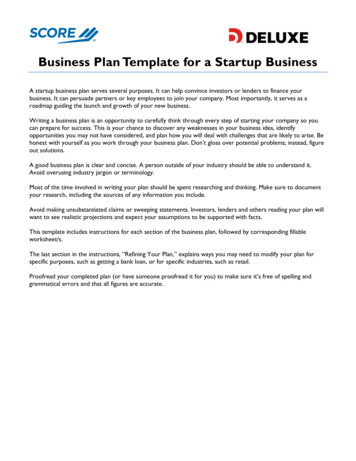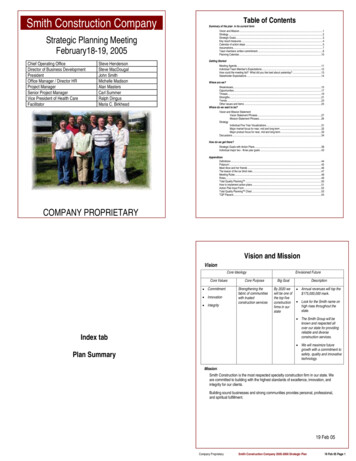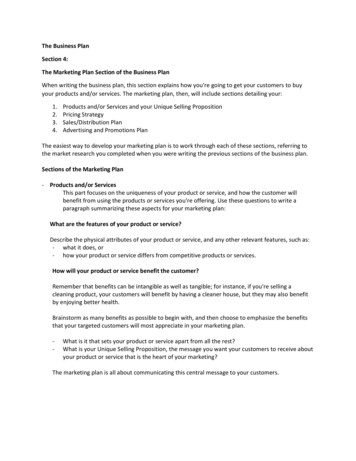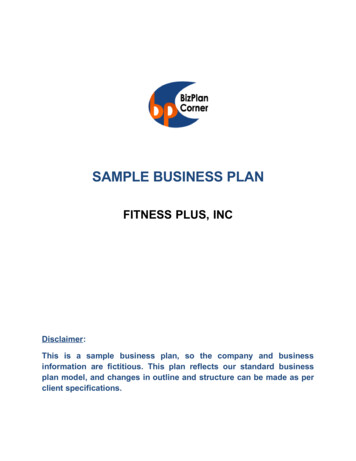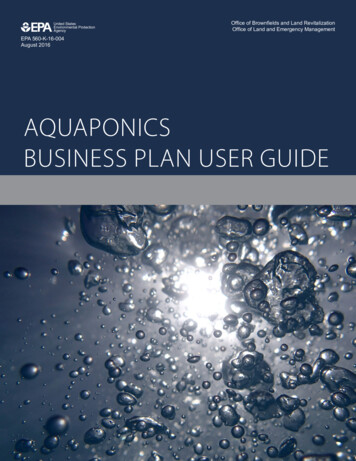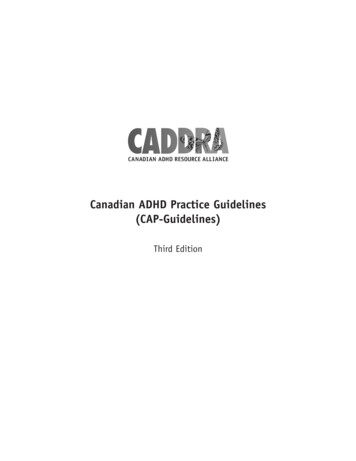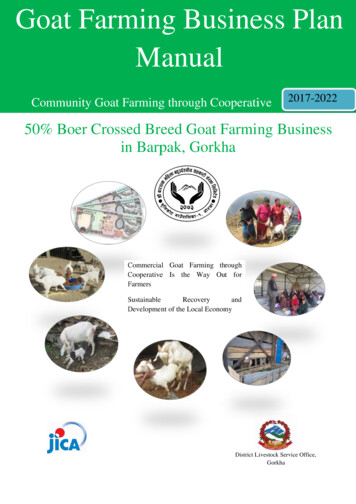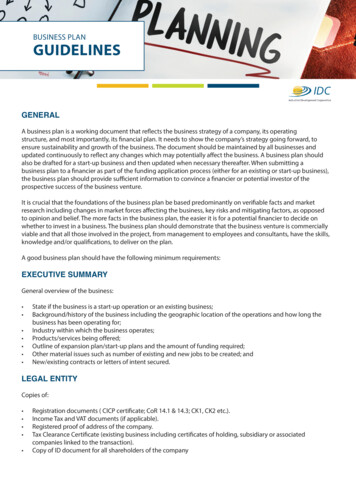
Transcription
BUSINESS PLANGUIDELINESGENERALA business plan is a working document that reflects the business strategy of a company, its operatingstructure, and most importantly, its financial plan. It needs to show the company’s strategy going forward, toensure sustainability and growth of the business. The document should be maintained by all businesses andupdated continuously to reflect any changes which may potentially affect the business. A business plan shouldalso be drafted for a start-up business and then updated when necessary thereafter. When submitting abusiness plan to a financier as part of the funding application process (either for an existing or start-up business),the business plan should provide sufficient information to convince a financier or potential investor of theprospective success of the business venture.It is crucial that the foundations of the business plan be based predominantly on verifiable facts and marketresearch including changes in market forces affecting the business, key risks and mitigating factors, as opposedto opinion and belief. The more facts in the business plan, the easier it is for a potential financier to decide onwhether to invest in a business. The business plan should demonstrate that the business venture is commerciallyviable and that all those involved in the project, from management to employees and consultants, have the skills,knowledge and/or qualifications, to deliver on the plan.A good business plan should have the following minimum requirements:EXECUTIVE SUMMARYGeneral overview of the business: State if the business is a start-up operation or an existing business;Background/history of the business including the geographic location of the operations and how long thebusiness has been operating for;Industry within which the business operates;Products/services being offered;Outline of expansion plan/start-up plans and the amount of funding required;Other material issues such as number of existing and new jobs to be created; andNew/existing contracts or letters of intent secured.LEGAL ENTITYCopies of: Registration documents ( CICP certificate; CoR 14.1 & 14.3; CK1, CK2 etc.).Income Tax and VAT documents (if applicable).Registered proof of address of the company.Tax Clearance Certificate (existing business including certificates of holding, subsidiary or associatedcompanies linked to the transaction).Copy of ID document for all shareholders of the company
SHAREHOLDERS AND MANAGEMENT Profiles of all shareholders/members, directors, senior management and key personnel (including contactdetails, education, work experience, and title or role within the company);Motivation that management has the necessary experience to successfully manage all aspects of thebusiness, including manufacturing (where applicable), operations, administration, human resources, financeand marketing;Signed (or at least draft) shareholder’s agreement or memorandum or incorporation;Amount of funds that shareholders will be injecting into the project as their own contribution and the sourceof these funds;Balance sheets of all shareholders (outlining assets and liabilities of the individual, trust, or company);Other business interests of shareholders and directors; andDetails of any other professionals assisting management, such as auditors or lawyers.BROAD-BASED BLACK ECONOMIC EMPOWERMENTBBBEE ratings certificate: If the Applicant is an existing business with a turnover of more than R10 million;If the Applicant does not have a rating, please do a self-assessment at http://bee.thedti.gov.za;andRemember that your BBBEE rating is not necessarily dependent on ownership alone.ORGANOGRAMS Group structure (if there is more than one within the applicant company).Hierarchy of staffLAND AND BUILDINGS Information on the right of use of the current or proposed premises from which the business undertakes itsoperations (e.g. proof of title, existing or proposed lease agreement, offer to purchase; or sale agreement);Proof that all necessary regulatory approvals have been obtained or at least applied for i.e. EnvironmentalImpact Assessments (EIA), rezoning of property rights (if required), etc. If these are yet to be obtained, pleaseprovide indicative timing for obtaining of such approvals;Motivation of the site in terms of logistics regarding raw material supply, target market etc.;Availability of bulk services such as water, electricity etc.;For land and buildings to be purchased, a valuation report not older than 18 months is necessary. Thevaluation report must be prepared by a registered independent professional valuer acceptable to the IDC,without restrictions in terms of the South African Council of the Valuers Profession (SACPVP) guidelines;Quotations for all building work or leasehold improvements to be performed; andTechnical drawings for all building work to be performed - this should be done by a qualified architectacceptable to the IDC and the necessary municipal approval obtained.CAPITAL EXPENDITURE Quotations from suppliers for all fixed assets to be purchased, time required for delivery after order placement,delivery and installation costs (not older than three months).Terms and conditions of payment for machinery to be purchased (deposits, progress payments etc.).Ensure that the fixed assets to be purchased are sufficient to meet production forecasts from a capacity (i.e.units produced per hour/day/week/month) and electricity consumption point of view.Be sure to budget adequately for other ‘soft assets’ such as office furniture, photocopy and fax machines as wellas other equipment that are necessary but not directly related to the production process.Copies of all warranties and guarantees, repairs and maintenance agreements relating to the assets to beacquired.The design, size, technology type, and layout of the plant and equipment.
PRODUCTION Production process description and process flow diagram or images.A copy of the factory/building layout.Identification of key suppliers and quotations for all raw material input costs (not older than three months).Details of any registered processes (patents, trademarks etc.) and terms of using the process or license ifapplicable.STAFFING Cost-to-company breakdown of all salaried, waged, part-time and contract employees, historical and goingforward. Indicate labour hours and number of shifts per day.- Number of staff and their salaries/wages, pensions, allowances, bonuses, commissions and other benefits byjob title or rank.- Current employment equity profile of staff and the proposed employment equity profile of staff post funding- Please include details of all staff, from part-time to director level.- Ensure that staff numbers are adequate and in line with production capacity and forecastsincluding labour hours and number of shifts- Ensure that salaries and wages are preferably market-related and not below minimumwage guidelines for the industry.- Details of any key and/or specialist skills and transfer of skills programme. o Bargaining councilcompliance certificates where applicable.MARKETING ANALYSIS Sales Projections:- Projected turnover levels need to be based on secured contracts, letters of intent and/orverifiable market research.- Copies of all contracts with customers, letters of intent from potential customers (detailingvolumes, prices and duration) and/or verifiable market research to be provided.- Turnover levels projected without any marketing backup or based purely on verbal agreements will besignificantly discounted, which could result in the business projections being non-viable.For existing businesses,- Details of existing contracts/orders being serviced and remaining periods and/or volumes on these contracts/orders.- Details of major customers and non-contract based work done each month over the past 12 months.A detailed marketing strategy and verifiable market research:Some of the areas that the marketing research should focus on are:- Competitor analysis (e.g. pricing, product or service portfolio, key target market andlocations etc.);- Competitive edge of the business;- Demand vs. supply;- Future developments (technological, new market entrants, alternate products etc.); o Other networks andrelationships created;- Selling strategy used (e.g. discounts offered, rebates etc.)FINANCIAL INFORMATION AND FORECASTS Detailed five-year income statement, balance sheet and cash flow forecasts. Show monthly forecasts for thefirst 12 months.Amount of funding applied for and how the funds are to be spent.Copies of agreements with other financiers for existing loans, including security offered for these loans.Details of overdraft and other debt facilities in place and security offered for these.For existing businesses and acquisitions, historical financial statements for two years (audited/draft whereapplicable) and latest management accounts (not older than three months).
NOTE IN PREPARING FINANCIAL PROJECTIONS:BALANCE SHEET Include all existing assets and liabilities as well as those that will be brought into the company as per thecurrent application for finance.For new loans, budget on realistic payback periods (usually five years for IDC purposes, but will depend on thecompany’s cash flow forecasts and may vary based on the industry).Working capital levels (debtors and creditors) to be budgeted for in terms of company’s payment policies or asnegotiated with debtors and creditors.Stock to be budgeted for based on anticipated stock levels to be held (include raw materials, work in progressand finished goods).Owners’ contribution towards the business to be included as shareholders’/members’ loans. This needs to beunencumbered, interest-free and with no fixed repayment terms.Non-distributable reserves must be based on valuations performed by a registered valuator.Details on value and nature of goodwill to be provided.INCOME STATEMENT Sales projections should tie in closely with any contracts and letters of intent obtained from potentialcustomers and marketing research performed. Sales should be conservatively phased into expected levelsover a reasonable period to allow for the time it will take topenetrate the market.Cost of sales to be accurately costed and budgeted for per product item.Take all possible expenses into account. Expenses frequently omitted include:- Depreciation;- Security costs;- Insurance costs;- Bank, audit, legal and IT related charges; o Interest costs; and- Royalties, commissions and discounts.All expenses in the income statement should be adequate for the size of the business and its operations. Forexample, the salaries and wages bill should be directly linked to the number of staff (including directors) to behired, multiplied by their total cost-to-company.Interest rates on all new IDC loans should be budgeted for at a minimum of prime. Other loans to be budgetedon actual, indicative or quoted prices.Normal company tax to be factored into the income statement.FOR ACQUISITIONS Target company’s past three years’ historical financial statements and latest management accounts (not olderthan three months).Company valuation.Include details of your due diligence on the target company, including a discounted cashflow valuation to confirm the company value.For IDC purposes, the following will apply:- The purchaser must be a historically disadvantaged person or majority black-owned business.- At least 50% of the total IDC funding required is to be reinvested into the company for growth and expansionand additional jobs must be created. Pure acquisitions may beconsidered for qualifying businesses e.g. Black Industrialist.- The purchase price for the business or assets needs to be to the satisfaction of the IDCas determined by a fair valuation methodology.- The purchase price may be paid to the seller over a period of two to three years, subject to pre-determinedtargets of profitability being achieved.
DISCLAIMER:Applicants should use their own preferred sources of information to compile business plans, based on the natureof their businesses;The above-mentioned information constitute a summary of our general guidelines, not an exhaustive list ofrequirements. Submission of an application in line with the guidelines do not guarantee that IDC willapprove a funding application.This Business Plan Guideline document is neither an agreement nor an offer. It is to provide theApplicant(s) with information to assist the Applicant to formulate its business plan. These guidelines do not claimto contain all the information each Applicant may require. Each Applicant should conduct its own investigationsand analysis and should check the accuracy, reliability and completeness of the information in this Business PlanGuidelines document and where necessary obtain independent advice.IDC makes no representation or warranty and shall incur no liability under any law, statute, rules or regulations asto the accuracy, reliability or completeness of this Business Plan Guidelines. IDC may in its absolute discretion, butwithout being under any obligation to do so, update, amend or supplement the information in thisBusiness Plan Guidelines and without notice.The Applicant hereby consents to the IDC providing the information submitted pursuant to a fundingapplication to a third party in adherence to the Promotion of Access to Information Act (“PAIA”) and other legislation should it be required to so disclose.The Business Plan Guidelines must be read in conjunction with the mandatory information anddocumentation to be made available to the Applicant by the IDC following receipt of the Application.
A business plan is a working document that reflects the business strategy of a company, its operating structure, and most importantly, its financial plan. It needs to show the company’s strategy going forward, to ensure sustainability and growth of the business

